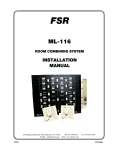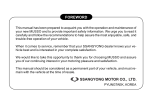Download FCC STATEMENT
Transcript
FCC STATEMENT This device complies with Part 15 of the FCC Rules. Operation is subject to the following two conditions: (1) This device may not cause harmful interference, and (2) This device must accept any interference received, including interference that may cause undesired operation. Note: This equipment has been tested and found to comply with the limits for Class B digital devices, pursuant to Part 15 of the FCC rules. These limits are designed to provide reasonable protection against harmful interference in a residential installation. This equipment generates, uses and can radiate radio frequency energy and, if not installed and used in accordance with the instructions, may cause harmful interference to radio communications. However, there is no guarantee that interference will not occur in a particular installation. If this equipment does cause harmful interference to radio or television reception, which can be determined by turning the equipment off and on, the user is encouraged to try to correct the interference by one or more of the following measures: Reorient or relocate the receiving antenna. Increase the separation between the equipment and receiver. Connect the equipment into an outlet on a circuit different from that to which the receiver is connected. Consult the dealer or an experienced radio/TV technician for help. Use of shielded cable is required to comply with Class B limits in Subpart B of Part 15 of the FCC rules. Do not make any changes or modifications to the equipment unless otherwise specified in the manual. If such changes or modifications should be made, you could be required to stop operation of the equipment. Notice: If static electricity or electromagnetism causes data transfer to discontinue midway (fail), restart the application or disconnect and connect the communication cable (USB, etc.) again. EN-1 TRADEMARK INFORMATION J J J J J Microsoft® and Windows® are U.S. registered trademarks of Microsoft Corporation. Pentium® is a registered trademark of Intel Corporation. Macintosh® is a trademark of Apple Computer, Inc. SDTM is a trademark. Other names and products may be trademarks or registered trademarks of their respective owners. READ THIS FIRST Notice: J J J J Product design and specifications are subject to change without notice. This includes primary product specifications, software, software drivers, and user’s manual. This User Manual is a general reference guide for the product. The product and accessories that come with your camera may be different from those described in this manual. This is due to the fact that different retailers often specify slightly different product inclusions and accessories to suit their market requirements, customer demographics, and geographical preferences. Products very often vary between retailers especially with accessories such as batteries, chargers, memory cards, cables, pouches, and language support. Occasionally a retailer will specify a unique product color, appearance, and internal memory capacity. Contact your dealer for precise product definition and included accessories. The illustrations in this manual are for the purpose of explanation and may differ from the actual design of your camera. The manufacturer assumes no liability for any errors or discrepancies in this user manual. EN-2 Safety Instructions Read and understand all Warnings and Cautions before using this product. WARNING If foreign objects or water have entered the camera, turn the power OFF and remove the battery. Continued use in this state might cause fire or electric shock. Consult the store of purchase. If the camera has fallen or its case has been damaged, turn the power OFF and remove the battery. Continued use in this state might cause fire or electric shock. Consult the store of purchase. Do not disassemble, change or repair the camera. This might cause fire or electric shock. For repair or internal inspection, ask the store of purchase. Do not use the camera in areas near water. This might cause fire or electric shock. Take special care during rain, snow, on the beach, or near the shore. Do not place the camera on inclined or unstable surfaces. This might cause the camera to fall or tilt over, causing injury. Keep the battery out of the reach of children. Swallowing battery might cause poisoning. If the battery is accidentally swallowed, immediately consult a physician. Do not use the camera while you are walking, driving or riding a vehicle. This might cause you to fall over or result in traffic accident. EN-3 CAUTION Insert the battery paying careful attention to the polarity (+ or –) of the terminals. Inserting the battery with its polarities inverted might cause fire and injury, or damage to the surrounding areas due to the battery rupturing or leaking. Do not fire the flash close to anyone’s eyes. This might cause damage to the person’s eyesight. Do not subject the LCD monitor to impact. This might damage the glass on the screen or cause the internal fluid to leak. If the internal fluid enters your eyes or comes into contact with your body or clothes, rinse with fresh water. If the internal fluid has entered your eyes, consult a physician to receive treatment. A camera is a precision instrument. Do not drop it, strike it or use excessive force when handling the camera. This might cause damage to the camera. Do not use the camera in humid, steamy, smoky, or dusty places. This might cause fire or electric shock. Do not remove the battery immediately after long period of continuous use. The battery becomes hot during use. Touching a hot battery might cause burns. Do not wrap the camera or place it in cloth or blankets. This might cause heat to build up and deform the case, resulting in fire. Use the camera in a well-ventilated place. Do not leave the camera in places where the temperature may rise significantly, such as inside a car. This might adversely affect the case or the parts inside, resulting in fire. Before you move the camera, disconnect cords and cables. Failure to do this might damage cords and cables, resulting in fire and electric shock. EN-4 Warning: TO PREVENT THE RISK OF FIRE OR ELECTRIC SHOCK, DO NOT EXPOSE THIS APPLIANCE TO RAIN OR MOISTURE FOR AMERICAN USERS The following advisory is included in accordance with the laws of the State of California (USA): WARNING: This product contains chemicals, including lead, known to the States of California to cause cancer, birth defects or other reproductive harm. Wash hands after handling. z This equipment has been tested and found to comply with the limits for a Class B digital device, pursuant to Part 15 of the FCC Rules. These limits are designated to provide reasonable protection against harmful interference in a residential installation. This equipment generates, uses and can radiate radio frequency energy and, if not installed and used in accordance with instructions, may cause harmful interference to radio communications. However, there is no guarantee that interference will not occur in a particular installation. If this equipment does cause harmful interference to radio or television reception, which can be determined by turning the equipment off and on, the user is encouraged to try to correct the interference by one or more of the following measures: * Reorient or relocate the receiving antenna. * Increase the separation between the equipment and receiver. * Connect the equipment into an outlet on a circuit different from that to which the receiver is connected. * Consult the dealer or an experienced radio/TV technician for help. z Changes or modifications not expressly approved by the party responsible for compliance could void the user’s authority to operate the equipment. EN-5 FOR CANADIAN USERS z This Class B digital apparatus complies with Canadian ICES-003 FOR EU USERS Note: z This symbol mark and recycle system apply to EU countries and do not apply to countries in other areas of the world. Your SANYO product is designed and manufactured with high quality materials and components which can be recycled and reused. This symbol means that electrical and electronic equipment, at their end-of-life, should be disposed of separately from your household waste. Please dispose of the equipment at your local community waste collection/recycling centre. In the European Union there are separate collection systems for used electrical and electronic products. Please help up to conserve the environment we live in! EN-6 Symbols used in this manual Points giving some extended instructions or special points to pay attention to. You many find the answers to questions or problems concerning camera operation in the sections “Troubleshooting”. FCC information Tested To Comply With FCC Standards FOR HOME OR OFFICE USE Declaration of Conformity Model number: VPC-S700 Trade Name: SANYO Responsible party: SANYO FISHER COMPANY Address: 21605 Plummer Street Chatsworth, California 91311 Telephone No.: (818) 998-7322 This device complies with Part 15 of the FCC Rules. Operation is subject to the following two conditions: (1) this device may not cause harmful interference, and (2) this device must accept any interference received, including interference that may cause undesired operation. Canadian ICES-003 information This class B digital apparatus complies with Canadian ICES-003. EN-7 Notes on Battery Usage When you use the battery, carefully read and strictly observe the Safety Instructions and the notes described below: J J J J J J J J J J Use only the specified battery. Avoid using the battery in extremely cold environments as low temperatures can shorten the battery life and reduce camera performance. When you are using the new rechargeable battery or rechargeable battery that has not been used for an extended period of time (the battery that passed the expiry date is an exception) might affect the number of images that can be captured. Therefore, to maximize its performance and lifetime, we recommend that you fully charge the battery and discharge it for at least one complete cycle before use. The battery may feel warm after long period of continuous use of the camera or the flash. This is normal and not a malfunction. The camera may feel warm after long period of continuous use. This is normal and not a malfunction. If the battery is not to be used for a long period of time, remove it from the camera to prevent leakage or corrosion. If the battery is not to be used for a long period of time, store it after no battery power left. If the battery is stored for a long time in a fully charged state, its performance may be impaired. Always keep the battery terminals in a clean state. Risk of explosion if battery is replaced by an incorrect type. Dispose of used batteries according to the recycle instructions. EN-8 CONTENTS 34 34 INTRODUCTION 11 12 Overview Package Contents GETTING TO KNOW THE CAMERA 13 14 16 Front View Rear View LCD Monitor Icons GETTING STARTED 18 18 19 20 21 22 Attaching the Camera Strap Inserting and Removing the Battery Inserting and Removing the SD/SDHC Memory Card (Optional Accessory) Setting the Date and Time Formatting the SD/SDHC Memory Card or Internal Memory Setting Image Resolution and Quality PHOTOGRAPHY MODE 25 26 27 28 29 30 31 32 [ ] Capture Mode Recording Voice Memos Using the Digital Zoom Setting the Flash Setting the Focus Setting the Self-timer Exposure Compensation/ Backlight Correction Setting the Scene Mode [ Setting the Panorama Mode [ ] Video Mode ] PLAYBACK MODE 35 36 36 37 37 38 39 41 42 43 Playing Back Still Images Playing Back Video Clips Playing Back Still Images/Video Clips on a TV Attaching Voice Memos Slideshow Display Zoom Playback Protecting Images DPOF Settings Resizing an Image Erasing Images MENU OPTIONS 45 47 49 50 51 52 53 Capture Menu (Capture) Capture Menu (Function) Video Menu (Capture) Video Menu (Function) Playback Menu Setup Menu (In Photography Mode) Setup Menu (In Playback Mode) CONNECTING TO A PICTBRIDGE COMPLIANT PRINTER EN-9 TRANSFERRING RECORDED IMAGES AND VIDEOS TO YOUR COMPUTER 56 Connecting the Camera to Your Computer 57 Downloading Images and Video Files EDITING SOFTWARE INSTALLATION 58 Installing Photo Explorer 58 Installing Photo Express 59 Installing Cool 360 CAMERA SPECIFICATIONS TROUBLESHOOTING EN-10 INTRODUCTION Overview Congratulations on your purchase of the new digital camera. Capturing high-quality digital images is fast and easy with this state-of-the-art smart camera. Equipped with a 7.0 megapixel CCD, this camera is capable of capturing images with a resolution of up to 3072 x 2304 pixels. Other features provided by the camera include the following: LCD monitor 2.4" full color LTPS-TFT LCD (115K pixels) monitor makes it easy to frame your subject when capturing images. It also displays the images you have captured. Recording media 16 MB internal memory. External memory supports SD/SDHC memory card. Optical zoom 3x optical lens allows you to capture telephoto and wide-angle images. Digital zoom 4x digital zoom and 3x optical zoom permit zoom photography of up to 12 times; 4x playback captured images to enlarge a selected portion of an image. Voice memo A voice memo can be recorded once for 30 seconds at photography mode immediately following a still image captured or at playback mode while viewing the images. Thumbnail display Display in sets of nine images on the LCD monitor for easier and quicker selection of images. Scene mode Simply select the scene mode that suits specific shooting conditions and subjects. This lets you shoot for the results you desire without complicated settings. EN-11 Package Contents Carefully unpack your camera and ensure that you have the following items. Common Product Components: J J J J J J J J Digital camera User’s manual Software CD-ROM USB cable Video cable Camera strap Camera pouch 2 x AA size batteries Common (Optional) Accessories: J SD/SDHC memory card EN-12 GETTING TO KNOW THE CAMERA Front View 1 2 3 4 1. Shutter button 2. ON/OFF button 3. Microphone 5 6 4. Flash 5. DC IN 3.3V terminal 6. PC/Video terminal 7. Lens 7 8. Self-timer LED 8 EN-13 Rear View 1 2 3 5 4 6 7 8 9 11 1. LCD monitor 5. 2. Status LED 6. 3. Mode switch 7. DISPLAY button Capture mode 8. Strap holder Video mode Playback mode Zoom in button 9. SET /Direction button 4. Zoom out button EN-14 10 MENU button Erase button 10. Battery/SD/SDHC memory card cover 11. Tripod socket SET /Direction button 1. 2. 3. 4. 5. S button Focus button X button Flash button T button Self-timer button W button Exposure/ Backlight correction button SET button EN-15 LCD Monitor Icons Capture mode [ 1. Zoom status 2. Voice memo 3. Remaining battery status ] Full battery power [ ] Medium battery power [ ] Low battery power [ [ ] No battery power ] AC adapter icon (if used) *[ 4. Flash mode [ Blank] Auto Flash ] Red-eye Reduction [ ] Forced Flash [ [ ] Flash Off ] Histogram 5. [ 6. Focus area (When the shutter button is pressed halfway) 7. Capture mode [Blank] Single ] Continuous [ [ AEB] AEB 8. Image size ] 3072 x 2304 [ ] 2560 x 1920 [ ] 1600 x 1200 [ [ ] 640 x 480 9. Possible number of shots J EN-16 P ] 10. Quality [ ] Fine ] Standard [ Economy [ ] 11. Date and time 12. Self-timer icon [ 10s] 10 sec. [ 2s ] 2 sec. [ 10+2s ] 10+2 sec. 13. Unsteady hold warning icon ] Exposure compensation 14. [ ] Backlight correction [ 15. Metering [Blank] Average ] Spot [ 16. White balance [Blank] Auto ] Incandescent [ [ 1 ] Fluorescent 1 [ 2 ] Fluorescent 2 ] Day Light [ ] Cloudy [ [ ] Manual 17. Focus mode [Blank] Auto focus ] Macro [ ] Infinity [ 18. Scene mode [ P ] ] [ ] [ ] [ [ ] ] [ ] [ [ ] ] [ ] [ [ TEXT ] ] [ ] [ [ ] ] [ ] [ [ ] ] [ ] [ [ ] ] [ Program AE Panorama Portrait Man Portrait Lady Landscape Sport Night Portrait Night Scene Candlelight Firework Text Sunset Sunrise Splash Water Flow Water Sepia Monochrome Snow Beach Pets User Setting Each press of the DISPLAY button switches one step in the sequence of OSD full display, OSD full with Histogram, OSD display off. Video mode [ 1. 2. 3. 4. 5. 6. 7. 8. 9. [ ] Video mode Zoom status Remaining battery status Image size Possible recording time / elapsed time Quality Recording indicator Self-timer icon Focus icon Playback mode [ 1. 2. 3. 4. 5. 6. 10S 00:07:30 ] -Still image playback Playback mode File number Folder number Protect icon Voice memo DPOF icon Playback mode [ 1. 2. 3. 4. 5. 6. 7. 8. 9. ] 1 6 ]-Video playback Video status bar Elapsed time File number Folder number Protect icon Video mode Playback mode Sound off icon (When the S button is pressed during video playback.) Total recorded time 1 9 Play 00:00:06 Total 00:00:10 2 100-0011 8 7 6 5 4 3 EN-17 GETTING STARTED Attaching the Camera Strap Attach the camera strap as shown in the illustration. Inserting and Removing the Battery You can use 2 AA size batteries (Ni-MH rechargeable or alkaline) to power the camera. Inserting the Battery 1. Open the battery/SD/SDHC memory card cover. 2. Insert the batteries in the correct orientation shown. 3. Close the battery/SD/SDHC memory card cover. Removing the Battery To remove the batteries, turn the camera off before removing batteries and hold the camera with the battery/SD/SDHC memory card cover facing upward, then open the battery/SD/SDHC memory card cover. J J J J EN-18 Be careful not to drop the batteries when opening or closing the battery cover. Due to the characteristics of AA alkaline battery, camera performance may deteriorate. AA alkaline battery is not recommended except in emergencies and checking the camera’s functionality. Please do not touch the battery springs when changing the batteries. Always keep the battery springs in a clean state. Otherwise, this will shorten the battery life. Inserting and Removing the SD/SDHC Memory Card (Optional Accessory) The digital camera comes with 16 MB of internal memory, allowing you to store captured still images or video clips in the digital camera. However, you can also expand the memory capacity by using an SD/SDHC memory card so that you can store more files. Inserting the SD/SDHC memory card 1. Open the battery/SD/SDHC memory card cover. 2. Insert the SD/SDHC memory card in the correct orientation shown. J Hold the SD/SDHC memory card with its front side of the SD/SDHC memory card (printed arrow) facing the rear side of the camera, and then insert the card as far as it can go. 3. Close the battery/SD/SDHC memory card cover. Removing the SD/SDHC memory card Open the battery/SD/SDHC memory card cover, press lightly on the edge of the SD/SDHC memory card and it will eject. J J J To prevent valuable data from being accidentally erased from an SD/SDHC memory card you can slide the writeprotected tab (on the side of the SD/SDHC memory card) to “LOCK”. To save, edit or erase data on an SD/SDHC memory card, you must unlock the card. Be sure to format an SD/SDHC memory card with this digital camera before using it. EN-19 Setting the Date and Time The date/time needs to be set if/when: Camera is turned on for the first time. Camera is turned on after leaving the camera without the battery for an extended period of time. When the date and time information is not displayed on the LCD monitor, follow these steps to set the correct date and time. 1. Slide the mode switch to [ ] or [ ]. 2. Press the MENU button and select [Setup] menu with the Xbutton. 3. Select [Date/Time] with the S / T buttons and press the SET button. The Date/Time setting screen will be displayed. 4. Select the item’s field with the W / X buttons and adjust the value for the date and time with the S / T buttons. The date and time is set in the order year-month-day-hourminute. The time is displayed in 24-hours format. SET:Adj. 5. After confirming all settings are correct, press the SET button. Capture Date/Time 03 / 01 / 2007 00 : 00 SET:Enter EN-20 Formatting the SD/SDHC Memory Card or Internal Memory This utility formats the internal memory (or memory card) and erases all stored images and data. 1. Slide the mode switch to [ ]. 2. Press the MENU button and select [Setup] menu with X button. 3. Select [Format] with the S / T buttons, then press the SET Play button. 4. Select [Execute] with the S / T buttons, and press the SET button. To cancel formatting, select [Cancel] and press the SET button. MENU:Exit SET:Adj. Format SET:Enter J J J J To format the internal memory, do not insert an SD/SDHC memory card into the camera. Otherwise, you will format the SD/SDHC memory card. Formatting the SD/SDHC memory card also erases the protected images. All data other than images are also erased. Before formatting the card, make sure that all the images are unnecessary. Formatting is an irreversible action and data cannot be recovered at a later time. An SD/SDHC memory card having any problem cannot be properly formatted. EN-21 Setting Image Resolution and Quality Resolution and quality settings determine the pixel size (dimension), image file size, and compression ratio for your images. These settings affect the number of images that can be stored. As you get to know the camera, it is recommended that you try each quality and resolution setting to get an appreciation for the effects that these settings will have on your images. Higher resolution and higher quality images offer the best photographic results but produce large file sizes. Therefore, few images will take up a lot of memory space. High resolution and quality settings are recommended for printed output and situations requiring the finest detail. Lower resolution/quality images take up less memory space and may be quite suitable for sharing images via e-mail, in a report, or on a web page. To change image resolution or image quality, perform these steps below: ] or [ ]. 1. Slide the mode switch to [ 2. Press the MENU button. J [Capture] menu is displayed. 3. Select [Size] with the S / T buttons, and press the SET button. 4. Select the desired setting with the S / T buttons, and press the SET button. 5. Select [Quality] with the S / T buttons, and press the SET button. 6. Select the desired setting with the S / T buttons, and press the SET button. 7. To exit from the menu, press the MENU button. Capture MENU:Exit SET:Adj. [ ] Mode Capture MENU:Exit SET:Adj. [ EN-22 ] Mode Possible number of shots (still image) The table shows the approximate shots that you can capture at each setting based on the capacity of the internal memory and the SD/SDHC memory card. Size 3072 x 2304 Quality SD/SDHC memory card capacity Internal Memory 64MB 128MB 256MB 512MB 1GB 2GB 4GB SDHC Fine 5 26 54 109 219 440 883 1746 Standard 6 30 62 125 253 507 1015 2008 Economy 8 38 78 157 316 634 1269 2510 Fine 78 157 316 634 1269 2510 8 38 Standard 10 47 96 193 389 780 1562 3090 Economy 12 56 113 229 460 922 1847 3652 Fine 17 80 162 327 658 1318 2638 5217 Standard 20 92 187 376 756 1515 3032 5996 Economy 23 103 209 420 844 1691 3386 6696 Fine 77 342 691 1388 2785 5578 11165 22076 Standard 82 366 739 1486 2982 5972 11954 23634 Economy 85 377 762 1531 3072 6153 12316 24351 2560 x 1920 1600 x 1200 640 x 480 EN-23 Possible recording time / sec (video clip) Size Quality Fine 640 x 480 * Memory 64MB SD/SDHC memory card capacity 128MB 256MB 512MB 1GB 2GB 4GB SDHC 00:00:06 00:00:27 00:00:55 00:01:51 00:03:43 00:07:28 00:14:57 00:29:34 Standard 00:00:07 00:00:31 00:01:02 00:02:06 00:04:13 00:08:28 00:16:57 00:33:31 Fine 320 x 240 Internal 00:00:18 00:01:23 00:02:48 00:05:38 00:11:18 00:22:38 00:45:18 01:29:35 Standard 00:00:22 00:01:38 00:03:19 00:06:40 00:13:24 00:26:50 00:53:43 01:46:13 If your memory card is not high speed write (over 2MB/Sec for random write), it will cause video clip auto stop or unexpected results. Your camera has to set to QVGA size and normal quality to prevent this problem if you want to use slow speed memory card. EN-24 PHOTOGRAPHY MODE [ ] Capture Mode Your camera is equipped with a 2.4" full color LTPS-TFT LCD monitor to help you compose images, playback recorded images/video clips or adjust menu settings. 1. Press the ON/OFF button to turn the power on. J The status LED lights green and the camera is initiated. J When the power is turned on, the camera will start in the mode that was set. J If the power is turned on at [ ] or [ ] mode, the lens will extend forward and it is ready for shooting. At ], the lens both modes, if the mode switch is set to [ barrel will retract into the camera body after 30 seconds. J If the power is turned on at [ ] mode, the lens will remain closed. ]. 2. Slide the mode switch to [ 3. Compose your image in the LCD monitor. J Pressing the button zooms in on the subject, and enlarges the subject on the LCD monitor. J Pressing the button provides a wider angle image. 4. Press the shutter button. J Pressing the shutter button down halfway automatically focuses and adjusts the exposure, and pressing the shutter button down fully captures the images. J The focus area frame turns blue when the camera is in focus and the exposure is calculated. J When the focus or exposure is not suitable, the frame of the focus area turns yellow. J If the photographic preview is set to “On”, the captured image will be displayed while the image is being recorded onto the SD/SCHC memory card. a Press down halfway b Press down fully EN-25 Recording Voice Memos A voice memo can be recorded once for 30 seconds at still image mode immediately following a still image captured. ]. 1. Slide the mode switch to [ Capture 2. Press the MENU button, and select the [Function] menu with the X button. J [Function] menu is displayed. 3. Select [Voice Memo] with the S / T buttons, and press the SET button. MENU:Exit SET:Adj. 4. Select [On] with the S / T buttons, and press the SET button. 5. Press the MENU button to exit from the menu. J [ ] icon is displayed on the screen. 6. Compose the image, press the shutter button down halfway, then press it down fully. J [VOICE RECORDING] is displayed on the screen immediately, and the voice memo recording starts. 7. Press the shutter button one more time during recording, or wait for 30 seconds. J [VOICE RECORD END] will be displayed and the recording will end. J An [ ] icon is displayed with images that have been recorded with a voice memo. J J EN-26 Voice memo is only available in [Single] capture mode. Voice memo is automatically fixed at [Off] in [Continuous] or [AEB] capture mode. Using the Digital Zoom Using a combination of 3 times optical zoom and 4 times digital zoom permits zoom photography of up to 12 times to suit the subject and the distance. The digital zoom is a compelling feature, the more an image is enlarged (zoomed), the more pixelated (grainier) the image will appear. ] or [ ]. 1. Slide the mode switch to [ 2. To enable the digital zoom: a. Press the MENU button. b. Select [Function] with the W / X buttons. c. Select [Digital Zoom] with the S / T buttons, and press the SET button. d. Select [On] with the S / T buttons again, and press the SET button. e. Press the MENU button to exit from the menu screen. f. To activate the digital zoom, press and hold the button completely until the image on the LCD monitor expands. Optical zoom 1X to 3X Digital zoom 1X to 4X 3. Press the shutter button to capture a “zoomed” image. J The zoom setting is automatically cancelled by either turning the camera off or the activation of the Auto Off function. EN-27 Setting the Flash Set the flash for capturing images. The flash firing mode can be set to suit for the photographic conditions. 1. Slide the mode switch to [ 2. Toggle the ]. button to select the desired flash mode. The available flash settings in different photography modes: Flash mode [ Blank ] Auto Flash ] Red-eye Reduction [ [ ] Forced Flash [ ] Flash Off EN-28 Description The flash fires automatically to suit the photographic conditions. Use this mode to reduce the red-eye phenomenon when you want to capture natural-looking images of people and animals in low-light conditions. When capturing images, the red-eye phenomenon can be reduced by asking the subject (person) to look at the camera or get as close to the camera as possible. In this mode, the flash always fires. Use this mode for photographing under artificial light such as backlighting. Use this mode when capturing images using indoor lighting, for stages and indoor competitions, and when the subject is too far away for the flash to be effective. Setting the Focus Images can be captured with the distance to the subject set by auto focus, [ 1. Slide the mode switch to [ 2. Toggle the ] or [ ] macro or [ ] infinity. ]. button to select the desired focus mode. The table below will help you choose the appropriate focus mode: Focus mode Description [ Blank]Auto Focus Selects this when you want to leave the settings up to the camera so that you can capture images without paying attention to settings. Approximately 40cm/15.7inches to infinity (both Wide and Tele). [ ] Macro Selects this when you want to capture a close up image. Wide (zoom off) : Approximately 6cm/2.4inches to infinity. Tele (at optical zoom 3x) : Approximately 35cm/13.8inches to infinity. [ ] Infinity Selects this when you want to capture images of subjects at a distance of infinity. EN-29 Setting the Self-timer This setting allows images to be captured with the self-timer. 1. Slide the mode switch to [ 2. Toggle the ] or [ ]. button to select the setting. For the [ OFF [ ] mode. 10s] 10 sec. [ 2s ] 2 sec. 10+2s ] 10+2 sec. [ For the [ ] mode. 10s ] 10 sec. [ 2s ] 2 sec. OFF [ 3. Compose the image, press the shutter button down halfway, then press it down fully. The self-timer LED flashes and the image is captured after the preset time has elapsed. The countdown is displayed on the LCD monitor. To cancel the self-timer during operation, press the shutter button halfway. The table below will help you choose the appropriate self-timer mode: Self-timer mode Description [ 10s] 10 sec. The image is captured about 10 seconds after the shutter button is pressed. [ 2s] [ 10+2s]10+2 sec. 2 sec. The image is captured about 2 seconds after the shutter button is pressed. One image is captured about 10 seconds after the shutter button is pressed, and the other image is captured again after 2 seconds. This is convenient when capturing group images in succession. EN-30 Exposure Compensation/Backlight Correction Images can be captured with the overall screen intentionally made brighter or darker. These settings are used when a suitable brightness (exposure) cannot otherwise be obtained in circumstance where the difference in brightness between the subject and the background (the contrast) is large, or when the subject that you want to photograph is very small within the screen. Exposure can be set in 0.3 EV units. ] and press the button. 1. Slide the mode switch to [ Each press of the button displays the setting in the order of [Blank], [ ] Backlight Correction, and [ ] Exposure Compensation. The exposure compensation value adjustment can only be made when the blue text appears. / buttons. 2. Set the exposure value with the Press the button to increase the value. Press the button to decrease the value. The setting range of the exposure compensation is as follows. -2.0, -1.7, -1.3, -1.0, -0.7, -0.3, 0, +0.3, +0.7, +1.0, +1.3, +1.7, +2.0 Press the button to confirm the setting. The larger the value, the brighter the image. The smaller the value, the darker the image. The set value is displayed on the screen. Effective Subjects and Set Values + (positive) compensation * Printed matter comprising black text on whitish paper * Backlighting * Bright scenes or strong reflected light such as ski slopes * When the sky accounts for a large area on the screen - (negative) compensation * People illuminated by a spotlight, in particular, against dark background * Printed matter comprising white text on blackish paper * Weak reflecting bodies such as evergreen trees or darkish leaves Backlight correction (+1.3, fixed) * When the background is bright and the subject is dark. * When subjects (people) have a light source such as the sun to their backs. EN-31 Setting the Scene Mode By simply selecting one of the following 21 modes, you can capture the image with most appropriate settings. ]. 1. Slide the mode switch to [ a. Press the MENU button. b. Select [Scene Mode] with the S/T buttons, and press the SET button. c. Select the desired scene mode with the S/T buttons, and press the SET button. 2. Compose the image, press the shutter button down halfway, and then press it down fully. The table below will help you choose the appropriate scene mode: Scene mode Description Select this mode to capture images without having to set special functions [ P ] Program AE or manual adjustments. However, this useful mode also allows you to make changes on camera settings to suit the photographic condition. ] Panorama Select this mode to take a series of shots then stitch them together with [ software to make a single image. ] Portrait Man Select this mode when you want to capture an image that makes a man [ stands out against a defocused (blurred) background. ] Portrait Lady Select this mode when you want to capture an image that makes a lady [ stands out against a defocused (blurred) background. [ ] Landscape Select this mode when you want to capture landscape images with bright color. [ ] Sport Select this mode when you want to capture fast-moving subjects. ] Night Portrait Select this mode when you want to capture people with an evening or night [ scene background. [ ] Night Scene Select this mode when you want to capture dark scenes such as night views. ] Candlelight Select this mode when you want to capture images of candlelit scene, without [ spoiling the atmosphere. ] Firework Select this mode when you want to capture fireworks clearly with optimal [ exposure. The shutter speed becomes slower, so using a tripod is recommended. EN-32 Scene mode [TEXT] Text [ ] Sunset [ ] Sunrise [ [ ] Splash Water ] Flow Water [ [ [ ] Sepia ] Monochrome ] Snow [ ] Beach [ ] Pets [ ] User Setting Description Select this mode when you want to capture an image that contains black and white subjects like printed documents. Select this mode when you want to capture images of a beautiful sunset shot that vividly captures beautiful red colors. Select this mode when you want to capture images of sunrise scene. This mode helps keep the deep hues in the scene. Select this mode when you want to capture images of splashing water. Select this mode when you want to capture the soft flowing water. Shutter speed is automatically slowed down while maintaining proper exposure, which produces an image with the water blurred into smooth flowing lines along with a sharply focused background. Select this mode when you want to capture a sepia image. Select this mode when you want to capture a black & white image. Select this mode when you want to capture clear snow scenes without darkened subjects and bluish tint. Select this mode when you want to capture bright beach scenes and sunlit water surfaces. Select this mode when you want to capture your pets. Shoot from the eye level of your pets. This mode allows you manually set the setting parameters and all these settings will be memorized. EN-33 Setting the Panorama Mode This mode is designed to make it easier to take a series of shots then stitch them together with software to make a single image. You can capture a photographic subject that won’t fit into a single frame, such as a landscape, and stitch it together later with a program such as Cool 360 or Photoshop application. ]. Slide the mode switch to [ Press the MENU button. Select [Scene Mode] with the S / T buttons, and press the SET button. Select [Panorama] with the S / T buttons, and press the SET button. Press the MENU button. Select the photographic direction with the W / X buttons. Shoot the first image. J The next image appears beside the previous image. 8. Orient the camera so that the second frame overlaps a small portion of the photographic subject of the first image and press the shutter button to capture the next image. 9. Follow the same steps to capture subsequent images in the sequence. 10. Finish the sequence by pressing the MENU button or switch to another mode after the last image has been recorded. 1. 2. 3. 4. 5. 6. 7. [ ] Video Mode This mode allows you to record video clips at a resolution of 320 x 240 / 640 x 480 pixels. You can select audio to be recorded or not. ]. 1. Slide the mode switch to [ 2. Compose the image. 3. Press the shutter button. J The recording of the video clip will start. J Pressing the shutter button one more time will end the recording of the video clip. J The recording time depends on the storage size and the subject of the image to be recorded. J Zoom function cannot be used during video recording. J J EN-34 When recording a video clip, the flash cannot be used. If the access speed of your SD/SDHC memory card is not enough for recording video clips in the ] will appear, and then the video recording will stop. currently selected quality, a warning icon [ In this case, select a video quality lower than the current one. [ ] PLAYBACK MODE Playing Back Still Images You can play back the still images on an LCD monitor. ]. 1. Slide the mode switch to [ J The last image appears on the screen. 2. The images can be fed in reverse or fed forward with the W / X buttons. J To view the previous image, press the W button. J To view the next image, press the X button. J Pressing the S / T buttons during image playback will result in a 90 degree rotated display. J The S button rotates the image counterclockwise and displays it, whereas the T button rotates the image clockwise and displays it. A press of the button opposite to the direction in which the image was rotated will return the image to the normal display. J Press the button to view the images in the thumbnail display. Images that have been selected with the S / T / W / X buttons will be indicated by a yellow frame. Press the SET button to display the selected image is displayed at its regular size. 1 100-0001 Image Display Information You can switch the state of the information display by pressing the DISPLAY button when playing back images. Each press of the DISPLAY button switches the information display state in the following order: ISO200 3072 x 2304 J J J [ ] icon is displayed with the video data. Video clips cannot be rotated. A [ ] icon is displayed with images which have an audio memo recorded. Press the SET button to playback the voice memo data. EN-35 Playing Back Video Clips You can play back video clips recorded on the LCD monitor. You can also play back sound if you recording with the audio. ]. 1. Slide the mode switch to [ J The last image appears on the screen. 2. Select the desired video clip with the W / X buttons. 3. Press the SET button. J A press of the X / W buttons during playback allows fast forward play / fast reverse play. J To stop video playback, press the T button. This stops playback and returns to the start of the video clip. J To pause video playback, press the SET button. This pauses video playback. To cancel pause, press the SET button again. J Video clips cannot be displayed rotated or enlarged. Playing Back Still Images/Video Clips on a TV You can also play back your images on a TV screen. Before connecting to any video devices, make sure to select NTSC/PAL to match the broadcast standard of the video equipment you are going to connect to the camera. ]. 1. Slide the mode switch to [ 2. Connect one end of the video cable to the PC/video terminal of the camera. 3. Connect the other end to the video input socket of the TV set. 4. Turn the TV and camera on. 5. Play back the still images/video clips. J The method of operation is the same as playing back still images and video clips on the camera. EN-36 Attaching Voice Memos A maximum of 30 seconds of audio can be recorded like a memo for captured still images. The voice memo can be recorded only once. ]. 1. Slide the mode switch to [ J The last image appears on the screen. 2. Select the image that you want to attach the voice memo with the W / X buttons. 3. Press the shutter button. J [VOICE RECORDING] is displayed on the screen and recording starts. 4. To stop recording voice memo during recording, press the shutter button again. J [VOICE RECORD END] will be displayed and the recording will end. A [ ] icon is displayed with images that have been recorded with a voice memo. Playing back voice memo A press of the SET button displays [VOICE PLAYBACK] and plays back the voice memo. J Voice memo is only available for still images. Slideshow Display The slideshow function enables you to playback your still images automatically in order one image at a time. ]. 1. Slide the mode switch to [ 2. Press the MENU button. J The playback menu is displayed. 3. Select [Slide Show] with the S / T buttons, and press the SET button. 4. Select the desired interval time with the S / T buttons, and press the SET button. J The slideshow starts. 5. To stop the slide show during playback, press the SET button. J The image is displayed on screen when you press the SET button. J J Play MENU:Exit SET:Adj. The Auto Off function does not operate during slide show. All still images in the folder are automatically played back. EN-37 Zoom Playback This mode also allows you to enlarge your image on the selected portion of the image to check for small details. ]. 1. Slide the mode switch to [ 2. Press the W / X buttons to select the image you want to enlarge. J You can also select the image you want to enlarge from the thumbnail display. buttons. 3. Adjust the zoom ratio with the / J Pressing the button enlarges the image. J To return to normal magnification, press the button. J The magnification factor is displayed on the LCD monitor. J The image is displayed enlarged, and a blue frame and yellow frame are displayed on the LCD monitor. J The blue frame indicates the entire image, while the yellow frame shows the location of the currently enlarged area. 4. Press the S / T / W / X buttons to select the area to enlarge. button until the regular display appears on the screen. 5. To return to regular display, toggle the J EN-38 The range of magnification factor is from 1x to 4x in 0.5x increments. Protecting Images Set the data to read-only to prevent images from being erased by mistake. Protecting Images ]. 1. Slide the mode switch to [ 2. Select the image that you want to protect with the W / X buttons. 3. Press the MENU button. J The playback menu is displayed. 4. Select [Protect] with the S / T buttons, and press the SET button. 5. Select [Single] or [All] with the S / T buttons, and press the SET button. 6. Select [Set] with the S / T buttons, and press the SET button. J Protection is applied to the image and the camera returns to the playback mode. J The protect icon [ ] is displayed with protected images. ] is displayed with all the When [All] has been selected, [ images. Play MENU:Exit SET:Adj. Play MENU:Exit SET:Enter Play MENU:Exit SET:Enter EN-39 Canceling the Protection To cancel protection for only one image, display the image that you want to remove the image protection. 1. Select [Protect] with the S / T buttons from the playback menu, and press the SET button. 2. Select [Single] or [All] with the S / T buttons, and press the SET button. 3. Select [Cancel Protect] with the S / T buttons, and press the SET button. J The removal of image protection is executed and the camera returns to the playback mode. Protecting multiple images simultaneously 1. Select [Protect] with the S / T buttons from the playback menu, and press the SET button. 2. Select [Select] with the S / T buttons, and press the SET button. J The images are displayed in the thumbnail display. 3. Select the image you want to protect with the S / T / W / X buttons, and press the DISPLAY button. J The protect icon [ ] is displayed with protected images. Selecting a protected image and pressing the DISPLAY button again will cancel the protection. This procedure is repeated to select multiple images. 4. Press the SET button. J Protection and cancellation the protection are executed and the camera returns to playback mode. J EN-40 Formatting an SD/SDHC memory card overrides protection, and erases all images regardless of their protected status. DPOF Settings DPOF is the abbreviation for Digital Print Order Format, which allows you to embed printing information on your memory card. You can select the images to be printed and how many prints to make with the DPOF menu in the camera and insert the memory card to the card compatible printer. When the printer starts printing, it will read the embedded information on the memory card and print the specified images. ]. 1. Slide the mode switch to [ 2. Select the image that you want to set DPOF with the W / X buttons. 3. Press the MENU button. J The playback menu is displayed. 4. Select [DPOF] with the S / T buttons, and press the SET button. J The DPOF setting screen is displayed. 5. Select [Single] or [All] with the S / T buttons, and press the SET button. J [Single]: Sets DPOF for each individual image. J [All]: Sets DPOF for all images at once. 6. Select [Print Num] with the S / T buttons, and press the SET button. J This displays the number of prints setting screen. 7. Set the number of prints with the S / T buttons, and press the SET button. J You can set up to 9 prints for each image. 8. Select [Date Print] with the S / T buttons, and press the SET button. J The date setting screen appears. 9. Select date to [On] or [Off] with the S / T buttons, and press the SET button. J [On]: The date of the image will also be printed. J [Off]: The date of the image will not be printed. Play MENU:Exit SET:Adj. Play MENU:Exit SET:Enter Play MENU:Exit SET:Enter EN-41 10.Select [Print Enable] with the S / T buttons, and press the SET button. 11.Select [Execute] with the S / T buttons, and press the SET button. J This creates a file containing the DPOF information, and when the operation is finished, the screen returns to the playback mode. J The DPOF icon [ ] is displayed on each image that has set up DPOF settings. J 1 100-0008 The date that is printed on the image is the date set on the camera. To print the correct date on the image, set the date on the camera before you capture the image. Refer to section in this manual titled “Setting the Date and Time” for further details. Resizing an Image Resizes a previously saved image. Resizing replaces the original image with the changed image. Only resizing to the smaller size is available. The following images cannot be resized: J Image size (640 x 480) J Image captured with other camera J Protected images J Video clips J Images cannot be resized when the SD/SDHC memory card is write protected 1. Select the image that you want to resize. 2. Press the MENU button. 3. Select [Resize] with the S / T buttons, and press the SET button. 4. Select the image size that you want to change with the S / T buttons, and press the SET button. J To quit resizing, press the MENU button. J When resizing ends, the screen returns to playback mode. J EN-42 Play MENU:Exit SET:Adj. It is possible to reduce the size of an image. It is not possible to increase the size of an image, or to restore size after it has been decreased. Erasing Images Erasing at Photography Mode (Quick Delete Function) The quick delete function enables you to delete the last-captured image during capture. ] or [ ]. 1. Slide the mode switch to [ button. 2. Press the J The last image and quick delete menu appear on the screen. 3. Select [Execute] with the S / T buttons. 4. Press the SET button to confirm the deletion. J To not delete, select [Cancel], and press theSET button. Delete Erasing at Playback Mode Erasing single image / Erasing all images ]. 1. Slide the mode switch to [ J The last image will be displayed on the screen. 2. Select the image you want to erase with the W / X buttons. button. 3. Press the J The deletion menu will be displayed. 4. Select [Single] or [All] with the S / T buttons, and press the SET button. J [Single]: Erases the selected image or the last image. J [All]: Erases all of the images except for the protected images. J [Select]: Erases a number of selected images. MENU:Exit SET:Enter Delete MENU:Exit SET:Enter EN-43 5. Select [Execute] with the S / T buttons, and press the SET button. J To not erase, select [Cancel], and press the SET button. J Deleting an image will not affect sequential image numbering. For example, if you delete image number 240, the next captured image will be numbered 241 even though 240 no longer exists. In other words, an image-number is retired when an image is deleted and will not be reused or reassigned to another subsequently captured image. Erasing selected images This erases a number of selected images. ]. 1. Slide the mode switch to [ button. 2. Press the J The deletion menu will be displayed. 3. Select [Select] with the S / T buttons, and press the SET button. J The images are displayed in the thumbnail display. 4. Select the image you want to erase with the S / T / W / X button. buttons, and press the J The [ ] icon will be displayed. One more press of the erase button will cancel the operation. Repeat this procedure and select all the images that you want to erase. 5. Press the SET button. Delete MENU:Exit SET:Enter 100-0002 100-0010 EN-44 MENU OPTIONS Capture Menu (Capture) This menu is for the basic settings to be used when capturing still images. ]. 1. Slide the mode switch to [ 2. Press the MENU button. J [Capture] menu is displayed. 3. Select the desired [Capture] option item with the S / T buttons, and press the SET button to enter its respective menu. 4. Select the desired setting with the S / T buttons, and press the SET button. 5. To exit from the menu, press the MENU button. Scene Mode Refer to section in this manual titled “Setting the Scene Mode” for further details. Size This sets the size of the image that will be captured. * [ ] 3072 x 2304 ] 2560 x 1920 * [ * [ ] 1600 x 1200 ] 640 x 480 * [ Capture MENU:Exit SET:Adj. Quality This sets the quality (compression rate) at which the image is captured. * [ ] Fine ] Standard * [ * [ ] Economy Capture Sharpness This sets the sharpness of the image that will be captured. * Hard / Normal / Soft MENU:Exit SET:Adj. EN-45 Saturation This sets the saturation of the image that will be captured. * High / Normal / Low White Balance This sets the white balance capturing under a variety of lighting conditions and permits images to be captured that approach the conditions that are seen by the human eye. * [ Blank ] Auto ] Incandescent * [ Fluorescent 1 * [ 1 ] Fluorescent 2 * [ 2 ] ] Day Light * [ ] Cloudy * [ ] Manual * [ Manual WB This manually sets the white balance and stores it. Use of this is convenient when the white balance does not offer a good match. Before select [Execute] determine the subject (such as a white paper) that will be used to set the white balance. * Cancel / Execute ISO This sets the sensitivity for capturing images. When the sensitivity is raised (and the ISO figure is increased), photography will become possible even in dark locations, but the more pixelated (grainier) the image will appear. * 50 / 100 / 200 / 400 / Auto Metering This sets the metering method for calculating the exposure. * [Blank] Average: Averages the light metered from the entire frame, but gives greater weight to the subject matter at the center. ] Spot: A very small portion of the center of the screen is measured, and the exposure * [ is calculated. EN-46 Capture Menu (Function) 1. Slide the mode switch to [ ]. 2. Press the MENU button, and select the [Function] menu with the X button. J [Function] menu is displayed. 3. Select the desired [Function] option item with the S / T buttons, and press the SET button to enter its respective menu. 4. Select the desired setting with the S / T buttons, and press the SET button. 5. To exit from the menu, press the MENU button. Capture MENU:Exit SET:Adj. Capture Mode This sets the recording * [Blank] Single: ] Continuous: * [ * [AEB] AEB: J method at the time of capturing images. Captures an image at a time. Permits continuous photography of 3 images max. Permits 3 consecutive images in the order of standard exposure, underexposure and overexposure compensation. In [Continuous] and [AEB] capture mode, the voice memo is automatically fixed at [Off]. Voice Memo Refer to section in this manual titled “Recording Voice Memos” for further details. * On / Off EN-47 LCD Bright. Select a brightness level for the LCD monitor. The LCD becomes brighter with the S button and darker with the T button. The adjustment range is from -5 to +5. Capture LCD Bright. MENU:Exit SET:Enter Digital Zoom This sets whether or not to use digital zoom at the time of photography. * On / Off J When [Voice Memo] is set to [On], the preview setting is also fixed at [On]. Preview This sets whether or not to display the captured image on the screen immediately after the image is captured. * On / Off J When [Preview] is set to [Off], [Voice Memo] setting is also fixed at [Off]. Date Print The date of recording can be printed directly on the still images. This function must be activated before the image is captured. * On / Off EN-48 Video Menu (Capture) This menu is for the basic settings to be used when recording video clips. ]. 1. Slide the mode switch to [ 2. Press the MENU button. J [Capture] menu is displayed. 3. Select the desired [Capture] option item with the S / T buttons, and press the SET button to enter its respective menu. 4. Select the desired setting with the S / T buttons, and press the SET button. 5. To exit from the menu, press the MENU button. Capture MENU:Exit SET:Adj. Size This sets the size of the video clip that will be captured. ] 640 x 480 * [ ] 320 x 240 * [ Quality This sets the quality (compression rate) at which the video clip is captured. ] Fine * [ ] Standard * [ Color This sets the color of the video clip that will be captured. * Normal / Vivid / Sepia / Monochrome EN-49 Video Menu (Function) 1. Slide the mode switch to [ ]. 2. Press the MENU button, and select the [Function] menu with the X button. J [Function] menu is displayed. 3. Select the desired [Function] option item with the S / T buttons, and press the SET button to enter its respective menu. 4. Select the desired setting with the S / T buttons, and press the SET button. 5. To exit from the menu, press the MENU button. Capture MENU:Exit SET:Adj. Audio This sets whether or not to record audio at the time of video recording. * On / Off LCD Bright. Refer to section in this manual titled “LCD Bright.” in Capture Menu (Function) for further details. Digital Zoom Refer to section in this manual titled “Digital Zoom” in Capture Menu (Function) for further details. EN-50 Playback Menu In the [ ] mode, set which settings are to be used for playback. 1. Slide the mode switch to [ ]. 2. Press the MENU button. J The playback menu is displayed. 3. Select the desired option item with the S / T buttons, and press the SET button to enter its respective menu. 4. Select the desired setting with the S / T buttons, and press the SET button. 5. To exit from the menu, press the MENU button. Play MENU:Exit SET:Adj. Slide Show Refer to section in this manual titled “Slideshow Display” for further details. DPOF Refer to section in this manual titled “DPOF Settings” for further details. Protect Refer to section in this manual titled “Protecting Images” for further details. LCD Bright. Refer to section in this manual titled “LCD Bright.” in Capture Menu (Function) for further details. Resize Refer to section in this manual titled “Resizing an Image” for further details. Quality Changes the quality (compression rate) of a recorded image. Compresses images down to half of their size or more, overwrites an old size images with a newly compressed image. Only quality changing to the lower quality level is available. Copy to Card Allows you to copy your files from the digital still camera’s internal memory to an SD/SDHC memory card. Of course, you can only do this if you have an SD/SDHC memory card installed and some files in internal memory. * Cancel / Execute EN-51 Setup Menu (In Photography Mode) Set your camera’s operating environment. ] or [ ]. 1. Slide the mode switch to [ 2. Press the MENU button, and select the [Setup] menu with the X button. J [Setup] menu is displayed. 3. Select the desired [Setup] option item with the S / T buttons, and press the SET button to enter its respective menu. 4. Select the desired setting with the S / T buttons, and press the SET button. 5. To exit from the menu, press the MENU button. Capture MENU:Exit SET:Adj. Beep This sets whether or not to mute the camera sound each time you press the camera button. * On / Off Fr. No. Reset This creates a new folder. The captured images are recorded to the newly created folder from number 0001. * Cancel / Execute Auto Off If no operation is performed for a specific period of time, the power to the camera is automatically turned off. This feature is useful to reduce battery wear. * 1 Min. / 2 Min. / 3 Min. / Off Date/Time Refer to section in this manual titled “Setting the Date and Time” for further details. Sys. Reset This returns all basic settings to the camera’s default settings. The time setting will not be reset. * Cancel / Execute Language Specify in which language menus and messages are to be displayed on the LCD monitor. EN-52 Setup Menu (In Playback Mode) 1. Slide the mode switch to [ ]. 2. Press the MENU button, and select the [Setup] menu with the X button. J [Setup] menu is displayed. 3. Select the desired [Setup] option item with the S / T buttons, and press the SET button to enter its respective menu. 4. Select the desired setting with the S / T buttons, and press the SET button. 5. To exit from the menu, press the MENU button. Play MENU:Exit SET:Adj. Beep Refer to section in this manual titled “Beep” in Setup Menu (In Photography Mode) for further details. Format Refer to section in this manual titled “Formatting the SD/SDHC Memory Card or Internal Memory” for further details. Fr. No. Reset Refer to section in this manual titled “Fr. No. Reset” in Setup Menu (In Photography Mode) for further details. Card Info. This displays the free capacity of the SD/SDHC memory card. System Info. This displays the firmware version of the camera. Language Refer to section in this manual titled “Language” in Setup Menu (In Photography Mode) for further details. Video Output This sets video output system of the video equipment that you are going to connect to the camera. * NTSC / PAL EN-53 CONNECTING TO A PICTBRIDGE COMPLIANT PRINTER If a printer that supports PictBridge is available, images can be printed by connecting the digital still camera directly to the PictBridge-compatible printer without using a computer. Connecting the camera to the printer 1. 2. 3. Connect one end of the USB cable to the PC/video terminal of the camera. Connect the other end of the USB cable to the USB port on the printer. Turn on your camera. J The [USB] screen appears. 4. Select [Printer] with the S / T buttons, and press the SET button. USB SET:Enter Printing images When the camera is properly connected to a PictBridge compliant printer, the PictBridge menu is displayed on the monitor. 1. 2. Select the item you want to configure with the S / T buttons, and press the SET button. J [Images]: Select whether you want to print specific image or all images. You may also select printing number for specific image. J [Date Print]: According to the printer type, select whether you want to print the image with date imprint or not. J [Paper Size]: Select the desired paper size according to the printer type. J [Layout]: Select the desired printing layout according to the printer type. J [Print]: After all settings are configured, select this item to start printing. If you select [Images] in the previous step, the figure shown on the right hand side will appear. Select [Select], [All] or [DPOF] with the S / T buttons, and press the SET button. J [Select]: Select to print one specific image. J [All]: Select to print all images. J [DPOF]: Select to print images with DPOF settings. J [Exit]: Exit from Images option. EN-54 PictBridge SET:Enter Images SET:Enter 3. If you select [Select] in the previous step, the figure shown on the right hand side will appear. J Select the image that you want to print with the W / X buttons. J Select the [Print Num] (up to 99) with the S / T buttons. J After selecting the desired image and printing number, press the SET button to confirm. Select 105-0003 4. Select [Exit] with the S / T buttons, and press the SET button. SET:Enter Images SET:Enter 5. Select [Print] with the S / T buttons, and press the SET button to start printing. SET:Enter 6. The printing starts and the figure shown on the right hand side appears. J The [COMPLETE] will be displayed temporarily, reminding you that the printing procedure is finished. J If a print error is detected, the [PRINT ERROR] will be displayed. PictBridge PRINTING EN-55 TRANSFERRING RECORDED IMAGES AND VIDEOS TO YOUR COMPUTER System Requirements Windows J Pentium III 600 MHz or higher J Windows 2000/XP/Vista J 64MB RAM J 128MB hard disk space J CD-ROM drive J Available USB port J J J J J J Macintosh PowerPC G3/G4 OS 9.0 or later 64MB RAM 128MB hard disk space CD-ROM drive Available USB port Connecting the Camera to Your Computer 1. Connect one end of the USB cable to the PC/video terminal of the camera. 2. Connect the other end of the USB cable to an available USB port on your computer. 3. Turn on your camera. J The [USB] screen appears. 4. Select [PC] with the S / T buttons, and press the SET button. 5. From the Windows desktop, double click on “My Computer”. USB 6. Look for a new “Removable disk” icon. This “Removable disk” is actually the memory card in your camera. Typically, the camera will be assigned drive letter “e” or higher. 7. Double click on the removable disk and locate the DCIM folder. 8. Double click on the DCIM folder to open it to find more folders. SET:Enter J Your recorded images and video clips will be inside these folders. J Copy & Paste or Drag-N-Drop image and video files to a folder on your computer. Mac users: Double-click the “untitled” or “unlabeled” disk drive icon on our desktop. iPhoto may automatically launch. EN-56 Downloading Images and Video Files When the camera is turned on and connected to your computer, it is considered to be a disk drive, just like a floppy disk or CD. You can download (transfer) images by copying them from the “Removable disk” (“untitled” or “unlabeled” disk on a Macintosh) to your computer hard drive. Windows Open the “removable disk” and subsequent folders by double clicking on them. Your images are inside these folder(s). Select the images that you want, and then choose “Copy” from the “Edit” menu. Open the destination location (folder) and choose “Paste” from the “Edit” menu. You may also drag and drop image files from the camera to a desired location. Macintosh Open the “untitled” disk icon, and the destination location on your hard disk. Drag and drop from the camera to the desired destination. J J Memory card users may prefer to use a memory card reader (highly recommended). Video playback application is not included with the package. Make sure that video playback application has been installed in your computer. EN-57 EDITING SOFTWARE INSTALLATION Installing Photo Explorer Ulead® Photo Explorer provides a simple and efficient way to transfer, browse, modify and distribute digital media. Acquire photos, video or sound clips from various digital device types and easily browse or add personal descriptions; make timely modifications; or distribute the media through the medium of your choice: E-mail, Print, Slideshow Presentations. It is an indispensable all-in-one tool for owners of digital cameras, WebCams, DV camcorders, scanners, or anyone who strives to effectively organize a large collection of digital media. To install Photo Explorer: 1. Insert the CD-ROM that came with the camera into your CD-ROM drive. The welcome screen appears. 2. Click “INSTALL PHOTO EXPLORER 8.0”. Follow the on-screen instructions to complete the installation. Installing Photo Express Ulead® Photo Express is complete photo project software for digital images. The step-by-step workflow, visual program interface, and in-program help assist users in creating exciting photo projects. Acquire digital photos effortlessly from digital cameras or scanners. Organize them conveniently with the Visual Browse mode. Use hundreds of ready-to-use templates such as albums, cards, posters, slideshows, and more. Edit and enhance images with photo editing tools, photographic filters, and special effects. Embellish projects by adding creative design elements such as frames, callouts, and stamp objects. Share results with family and friends via e-mail and multiple print options. To install Photo Express: 1. Insert the CD-ROM that came with the camera into your CD-ROM drive. The welcome screen appears. 2. Click “INSTALL PHOTO EXPRESS 5.0”. Follow the on-screen instructions to complete the installation. EN-58 Installing Cool 360 Ulead® COOL 360™ quickly and easily allows photo editing consumers to transform a series of photos into 360o or wide-angle panoramic scenes for an immersive viewing experience. COOL 360’s intuitive interface and easy-to-use wizard deliver great-looking panoramas fast while advanced warping, blending and alignment tools ensure excellent results. Share finished panoramas via email, create Web pages or insert them into documents and presentations. To install Cool 360: 1. Insert the CD-ROM that came with the camera into your CD-ROM drive. The welcome screen appears. 2. Click “INSTALL Cool 360 SE” . Follow the on-screen instructions to complete the installation. J J J J For more information about the operation of the application software, refer to its respective help documentation. For Windows 2000/XP users, please make sure to install and use the application software in “Administrator” mode. The application software are not supported on the Mac. The application software are not supported on the Windows Vista. EN-59 CAMERA SPECIFICATIONS Item Image sensor Image resolution LCD monitor Recording media Compression format File format Lens Focus range Shutter speed Digital zoom Flash effective range Terminal Power supply Dimension Weight Description 1/2.5” CCD sensor (7.0 megapixels) <Still image> 3072 x 2304, 2560 x 1920, 1600 x 1200, 640 x 480 <Video clip> 640 x 480 (30 fps), 320 x 240 (30 fps) 2.4” full color LTPS-TFT LCD (115K pixels) 16 MB internal memory Supports SD/SDHC memory card (up to 4 GB) (optional) JPEG DCF, EXIF 2.2, DPOF, AVI 3x optical zoom lens Aperture range: 2.8(W) – 4.8(T) Focal length: 5.8mm – 17.4mm (equivalent to 35mm – 105mm on a 35mm camera) Standard: Approx. 40cm/15.7inches to infinity Macro: Approx. 6cm/2.4inches to infinity (Wide) Approx. 35cm/13.8inches to infinity (Tele) 1 – 1/1000 sec. 4x (Capture mode) 4x (Playback mode) 0.6m - 3.0m (Wide) 0.6m - 2.1m (Tele) DC IN 3.3V USB 2.0 (Full speed) / Video OUT 2 x AA (Ni-MH rechargeable or alkaline) batteries AC power adapter (optional) Approx. 89.4 x 62 x 26mm (without protruding parts) Approx. 130g (without battery and SD/SDHC memory card) *Design and specifications are subject to change without notice. EN-60 TROUBLESHOOTING Refer to the symptoms and solutions listed below before sending the camera for repairs. If the problem persists, contact your local reseller or service center. Power Supply Cause The batteries in not inserted. The batteries are exhausted. The camera was left unattended and unused, so the auto power off cuts it off. It is being used in extreme low temperature. The rechargeable batteries Many shots are being captured in dark places inside, requiring flash. run out quickly. The rechargeable batteries are not fully charged. The rechargeable batteries are not used for an extended period of time after charged. The battery or camera feels Long period of continuous use of the camera or the flash. warm. Symptom The power does not come on. The power cuts out during use. Solution Insert the batteries correctly. Insert a set of new batteries. Turn the power back on. Fully charge the rechargeable battery and discharge them for at least one complete cycle before use to maximize their performance and lifetime. EN-61 Shooting Symptom Cause The battery is running low. The power is not on. The camera is not in shooting mode. The shutter button is not pressed all the way down. The memory card does not have any Even if I press the shutter free capacity. button, the camera does End of memory card life. The flash is charging. not shoot. The memory card is unrecognized by the camera. The auto power off function is activated. The memory card is write-protected. The power is not on. Images do not appear on LCD monitor is dark. the LCD monitor. Although it is set to auto The lens is dirty. The distance to the subject is smaller focus, it does not focus. than the effective range. The flash does not fire. The flash is set to flash off. The flash cannot recharge. Even though the flash fired, The distance to the subject is greater the image is dark. than flash effective range. The image is captured in a dark place while set to flash off. The image is dark. It is under-exposed. The image is too bright. It is over-exposed. The image lacks natural color. The image was captured in conditions that are hard for auto white balance to adjust to. EN-62 Solution Recharge the battery. Turn the power on. Slide the mode switch to shooting mode. Press the shutter button all the way down. Insert a new memory card, or delete unwanted files. Insert a new memory card. Wait until the status LED off. Format the memory card in this camera before its first use or when it was used other than this camera. Turn the power on again. Remove the write-protection. Turn the power on. Adjust the brightness of the LCD monitor in the menu. Wipe clean with a soft, dry cloth or lens paper. Get your subject within the effective focus range. Set the flash to something other than flash off mode. Get closer to your subject and shoot. Set the flash to something other than flash off mode. Set the exposure compensation to a larger value. Set the exposure compensation to a smaller value. Add a white object to the composition. Playback Symptom Cannot playback. The contents of memory card cannot be played back. Cause It is not set to playback mode. You played back a memory card that was not formatted by this device. The file is protected. You played back a memory card that Files cannot be deleted. was not formatted by this device. The memory card is write-protected. Cannot format a memory The memory card is write-protected. card. End of memory card life. The playback image is dark though I used the flash. The LCD monitor is too dark. Solution Slide the mode switch to playback mode. Insert a memory card that was formatted and stored on by this device. Cancel protection. Insert a memory card that was formatted and stored on by this device. Remove the write-protection. Remove the write-protection. Insert a new memory card. Adjust the brightness of LCD monitor. Other Problems Symptom Even when the camera’s buttons are pressed, it does not operate. The date and time is wrong. The date set has disappeared. Cause Solution The batteries are running low. Insert a set of new batteries. The correct date and time in not set. Set the correct date and time. The batteries are removed with the Set the date and time again. power still on. About connecting to your computer/software Cause Solution Check whether the hard disk has a space for running Windows, and if The free space on the hard disk in C a n n o t d o w n l o a d your computer may be insufficient. the drive for loading image files has a capacity at least that of the memory images. card inserted in the camera. Insert a set of new batteries. No power supply. Turn the power on. Symptom EN-63
































































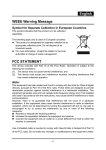
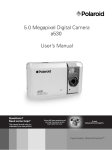
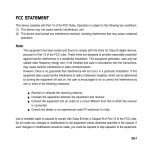
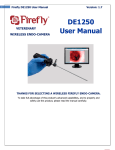
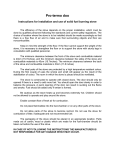
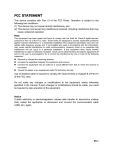
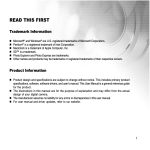
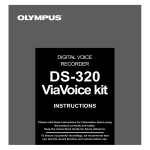
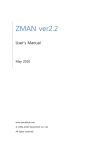
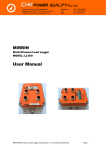
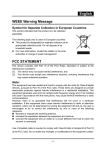
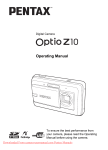
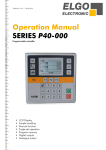
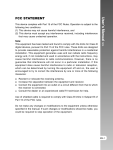
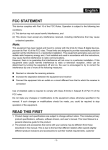
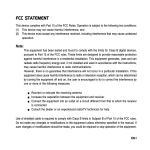

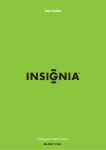
![[ ] playback mode](http://vs1.manualzilla.com/store/data/005894332_1-eb04455062e124c285a30d79ed1ad6c3-150x150.png)
